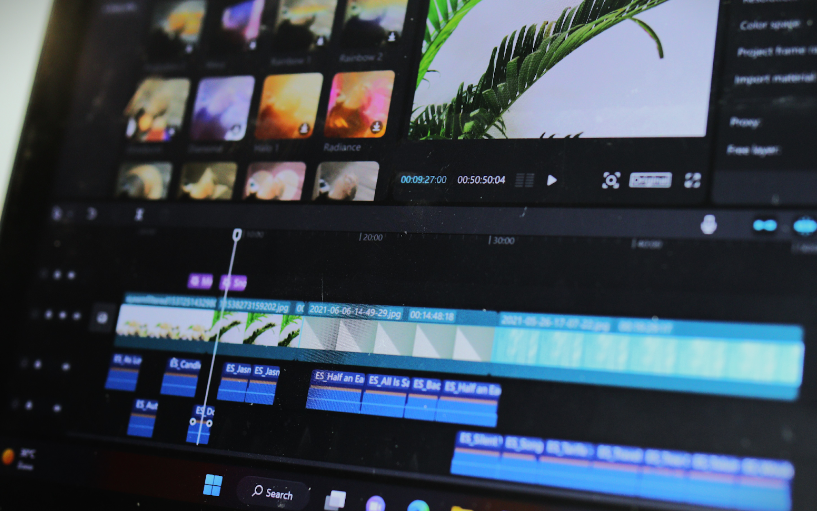Do the words 'author video' fill you with fear? Hate the process of filming yourself? Check out VEED'S guide to video creation and editing.

Did you know that the earliest known form of storytelling through visuals dates back to the Lascaux Cave paintings, created by our ancestors over 17,000 years ago? Throughout history, from the invention of the printing press to the rise of television, authors have adapted to new mediums to share their stories. In the 21st century, video content has taken centre stage as a powerful means of communication.
According to recent statistics, video content on social media generates 1200% more shares than text and images combined. Plus, 72% of users prefer learning about a brand through video. As an author, tapping into this trend can be a big step in your journey. But where do you start?
In this article, we'll look at the different types of videos you can make as well as exploring best practices in creating and editing them.
Different Types of Author Videos
-
Book Trailers
Book trailers are cinematic teasers for your literary masterpieces. Much like movie trailers, these videos convey the message of your books and promote excitement among your readers. -
Author Interviews
Invite your readers into your personal space through author interviews. You can share your experiences, inspirations, and motivations in these intimate conversations.
You can also discuss the beginning of your stories, your writing process, and the challenges you've overcome. By revealing the person behind the pen, you humanize your work and make yourself more relatable to your readers. -
Reading Excerpts
Reading excerpts aloud brings your book to life in a way that printed words cannot. You can give your readers an auditory and emotional experience by vocalizing your characters' dialogues and narrating pivotal scenes. -
Behind-the-Scenes
Offer your readers a peek into your creative process, as they are the ones who appreciate the dedication and passion behind your work. Showcase your writing space, share insights into your research methods, and reveal the objects that inspire your stories. By doing this, you’ll create a relatable narrative and cultivate a stronger bond with your readers. -
Writing Tips
Leverage your expertise to empower aspiring writers. You can create videos where you share valuable tips, techniques, and insights into the craft of writing. You can also address writers' common challenges, offer practical solutions, and encourage creativity.
Doing this not only enhances your credibility but offers a meaningful contribution to the literary community. -
Book Reviews
Engage with the broader literary community by becoming a literary critic. You can review the works of fellow authors and share your insights or opinions. Showcasing your analytical skills and passion for literature can establish yourself as a discerning voice in the literary landscape. -
Live Readings
You can also host live readings of your books to allow readers to experience your narrative as it evolves. Invite questions, interact with your readers, and create an immersive literary event. Live readings provide a unique opportunity to build excitement around your latest release or celebrate significant milestones with your readership. -
Workshop Videos
Conduct writing workshops through video format, where you can delve deep into specific aspects of the writing process. Teach your audience about character development, plot structure, or any other writing-related topic you excel in.
Pre-Production

Before the camera starts rolling and the creative magic starts, proper pre-production strategies should be laid down for a seamless video production process. Below are five essential aspects of pre-production that can help bring your vision to life on screen.
Step 1. Choose the Right Video Format
The first step in pre-production is defining the format that best suits your content. Will it be a vlog-style video, an intimate interview, or a more creatively orchestrated piece? Understanding the nature of your content helps select the most appropriate format and sets the tone for the entire production.
This is also where you decide if you'll create a long-form or short-form piece. Long-form content typically ranges from 15 minutes to several hours, allowing for in-depth exploration of topics. Short-form content, on the other hand, is concise and usually under 5 minutes, focusing on quick and engaging delivery.
Your choice depends on your target audience's preferences and the depth of information you want to convey.
Step 2. Write a Script
Screenplays and scripts have been essential filmmaking components since the industry's development. Legendary screenwriters like William Goldman and Billy Wilder set the stage for the importance of well-crafted narratives in film.
A well-written script ensures your message is clear, concise, and impactful. It outlines the dialogue, scenes, and actions, providing a roadmap for both you, the creator and your audience as the viewers.
Step 3. Plan Your Shoot
In the early days of filmmaking, producers often used hand-drawn storyboards to visualize scenes and camera angles. Nowadays, you have access to a wide range of planning tools, including storyboards, shot lists, and previsualization software. Consider every aspect, from the choice of location to the selection of props and costumes.
Step 4. Find the Right Equipment
Investing in the right equipment is vital to achieve professional-grade video production. Here's a checklist of essential gear:
-
A good quality camera or smartphone - the primary tool capturing your visual narrative, ensuring clarity and detail in every frame.
-
Tripod or stabilizer - helps maintain stable shots, which is crucial for professional-looking videos.
-
Microphone for clear audio - clear audio is as important as high-quality visuals.
-
Lighting equipment - proper lighting controls the ambiance and mood of your video.
-
Green screen (if needed) - provides the flexibility to change backgrounds, adding a layer of creativity to your videos.
-
Props and costumes (if needed)- thoughtfully chosen props and costumes enhance the visual appeal, adding depth and authenticity to your scenes.
-
Editing software for post-production - refines your footage, adds effects, and ensures seamless transitions between scenes.
Step 5. Gather Visual Assets
To beef up the visual appeal of your video, gather a diverse range of visual assets. Collect high-quality images, videos, and graphics that are helpful for your narrative. These assets serve as visual supplements and enrich your video content.
Production

As you transition from the pre-production phase to the production phase, the spotlight shifts to the practical aspects of bringing your video vision to life. In this phase, attention to detail is crucial. In this section, we'll discuss tips and techniques to help you capture high-quality footage and elevate your video production.
Tip 1. Maintain Steady Shots
A fundamental rule of video production is to keep your shots steady. Unwanted camera shakes can detract from the overall quality of your video. To achieve this, invest in a reliable tripod or stabilizer that provides stability and smooth motion, ensuring your footage is free from distracting jitters.
Tip 2. Ensure Good Lighting
It's imperative to avoid harsh shadows and ensure even, flattering lighting on your subjects. Experiment with natural light or use professional lighting equipment to create the desired visual atmosphere.
Tip 3. Use an External Microphone
While visuals are crucial, clear and crisp audio is equally important. Invest in an external microphone to capture high-quality sound. The microphone should be positioned strategically to pick up audio without unwanted noise or interference, ensuring your viewers hear your message clearly.
Tip 4. Frame Your Shots Thoughtfully
Your shots are the canvas upon which your narrative develops. Thoughtful framing is essential to capture the essence of your content. Consider the composition, angles, and perspectives that best convey your message. Every frame should be purposeful, contributing to the overall storytelling experience.
Post-Production

Once the production phase has wrapped, it's time to breathe life into your raw footage and refine it into a polished masterpiece. Among the essential tools in your post-production arsenal are VEED's tools, which offer an array of functionalities to level up your videos.
Video Cutter and Trimmer
Video cutter and trimmer are tools that allow you to edit your video, removing unnecessary parts and ensuring that every moment contributes to the overall narrative. Trim away any distractions or gaps, leaving a concise and engaging visual story behind.
Background Noise Remover
High-quality audio is a sign of professional video production. VEED's background noise remover comes to your aid by eliminating unwanted noise and ensuring clear audio.
Video Resizer
VEED's video resizer tool allows you to optimize your videos to adapt to different platforms. It ensures that your content looks its best whether viewed on a smartphone, computer, or TV screen. This versatility enhances the application of your video.
Video Translator
Expand your reach even further by using the video translator tool. With this feature, you can easily add subtitles in multiple languages, making your video content accessible and relatable to diverse audiences worldwide.
Eye Contact Corrector
For your interviews and direct-to-camera segments, eye contact is crucial for viewer engagement. VEED's eye contact corrector adjusts eye contact in interviews, ensuring your audience won’t be distracted by your eye movements.
Captions and Subtitles Generator
VEED's captions and subtitles generator enable you to make your video accessible to broader viewers. Adding subtitles in multiple languages breaks down language barriers. Captions also enhance comprehension, making your content more inclusive.
With the right guidance and a toolkit filled with powerful tools, the art of video creation becomes not just accessible but an integral part of an author's creative journey. Use this exciting way to connect with your readers and share your love for writing.
Video isn't just a medium; it's a gateway to appealing narratives, a bridge between imagination and reality. So, take that leap, start your video journey today, and watch as your words spring to life.
Comments